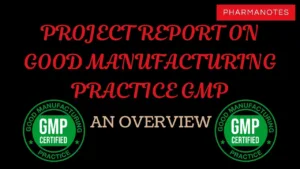PROJECT REPORT ON GOOD MANUFACTURING PRACTICE GMP: AN OVERVIEW

GOOD MANUFACTURING PRACTICE (GMP):
GOOD MANUFACTURING PRACTICE GMP is that part of Quality Assurance that ensures that products are consistently produced and controlled to the quality standard appropriate to their intended use and as required by the marketing authorization.
Good Manufacturing Practices (GMPs) are regulations that describe the methods, equipment, facilities, and controls required for producing:
Human and veterinary products
Medical devices
Processed food
Usually see “cGMP” – where c = current, to emphasize that the expectations are dynamic. It is designed to minimize the risks involved in any pharmaceutical production that cannot be eliminated through testing the final product.
These regulations, which have the force of law, require that manufacturers, processors, and packagers of drugs, medical devices, some food, and blood take protective steps to ensure their products are safe, pure, and effective.
Require a quality approach to manufacturing, enabling companies to minimize or eliminate instances of contamination, mix-ups, and errors.
Protects the consumer from purchasing a product, which is not effective or even dangerous. GMP regulations address issues including record keeping, personnel qualifications, sanitation, cleanliness, equipment verification, process validation, and complaint handling.
In short, GMP makes the difference between nearly right and exactly right.
Why GMP?
Final testing of the product cannot ensure the Quality efficiency and safety.
Final testing may always not detect contamination, error, etc.
Conformance to the predetermined specification.
To minimize contamination eg:- microbial contamination.
To eliminate error.
To produce product of consistent quality.
Government requirement.
Ensure quality product.
Reduce rejects, recalls.
Satisfied customers.
Company image and reputation.
DOWNLOAD PROJECT REPORT ON GOOD MANUFACTURING PRACTICE GMP
Also, Visit: Training Report for pharma students
